🚀 It’s live! Access exclusive 2025 live chat benchmarks & see how your team stacks up.
Get the data🚀 It’s live! Access exclusive 2025 live chat benchmarks & see how your team stacks up.
Get the data
Customer service expectations have never been higher. Thanks to the development of technology, consumers expect fast, accessible, and accurate support all day, every day. The burden now firmly sits with organizations of all sizes and industries to match these expectations – or lose out on business.
When today’s customers reach out for support, they want support anytime, anywhere, effortlessly. Phone support alone doesn’t cut it, and nor does email. To match customer expectations, organizations must adopt a digital-first approach to customer experience (CX) and put the most popular customer service channel at the core – a live chat platform.
Thanks to its speed and convenience, a live chat tool empowers agents to provide the type and quality of support that today’s consumers need, all while:
This live chat software guide will provide a comprehensive overview of this technology, explaining the who, what, when, where, and why of live chat software. By the end, you’ll understand why a live chat platform is the best CX solution for both customers and businesses alike, and how you can easily set it up within your organization.

Let’s begin this live chat software guide by explaining what a live chat platform is and how it works.
Live chat is a web tool that allows website visitors to message in real-time with support agents. The live chat interface is a chat window similar to messaging apps. When live chat is set up on a site, a button is placed prominently for visitors to interact with. Clicking this button opens a chat window connecting visitors instantly with an agent for support, sales, technical help, or anything else they might need assistance with.
A robust live chat tool can also notify agents of website visitors that may appear to need support, or automatically trigger messages to be sent to these visitors.
Over the years, live chat platforms have grown exponentially in consumer popularity. 73% of consumers now agree that live chat is the most satisfactory way to communicate.
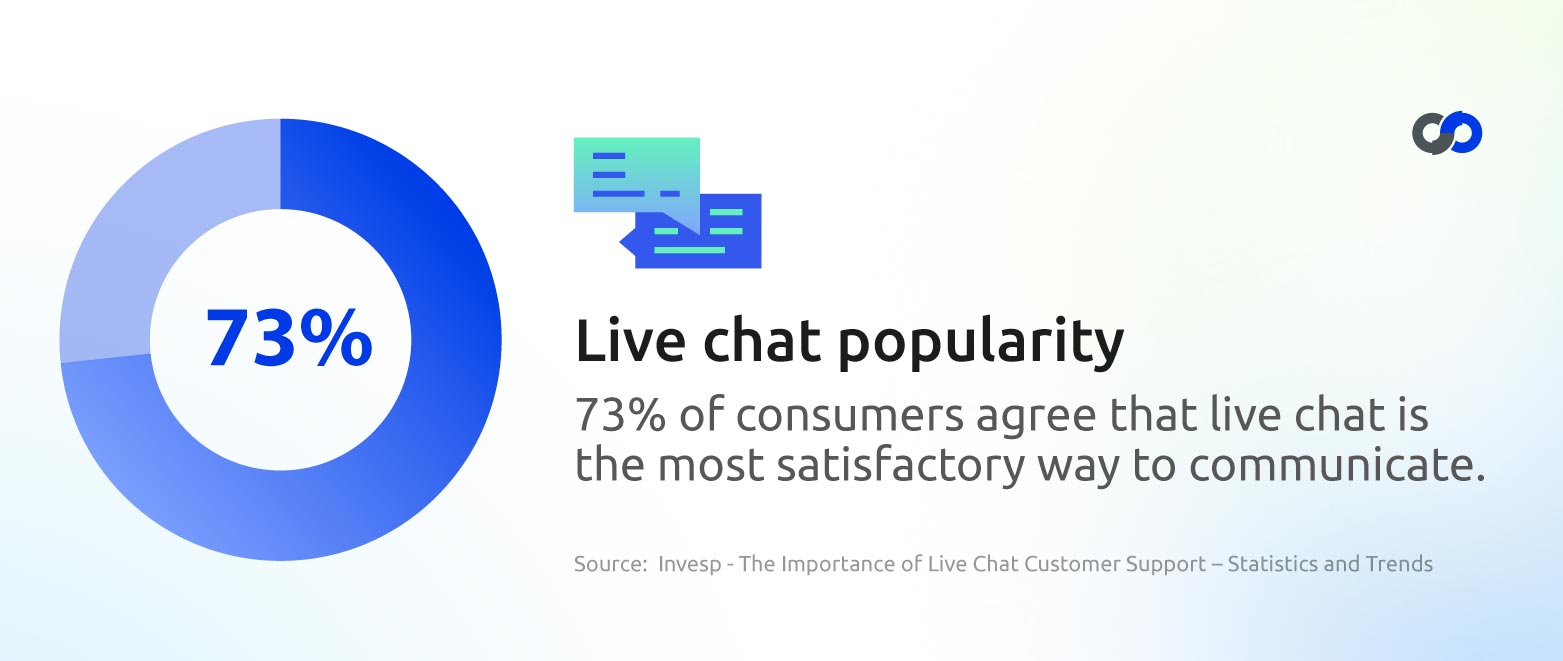
There are many reasons for the popularity of live chat platforms, many of which have been driven by recent tech trends and consumer expectations. Here are some of them:
A live chat platform caters to these key consumer needs. We’ll dig deeper into the benefits of live chat for customer service in the next chapter.

We began this guide by discussing the high expectations of today’s customers, and it’s time we looked at how those expectations translate in customer service & support.
Today’s customers demand quick, convenient, and personalized customer support that shows companies understand them, their needs, and are treating them like a valued individual. The stats in the graphic below illustrate the balance that organizations must now maintain. 90% of consumers rate an immediate response as ‘important or very important’, while the same percent want the experience to be convenient.
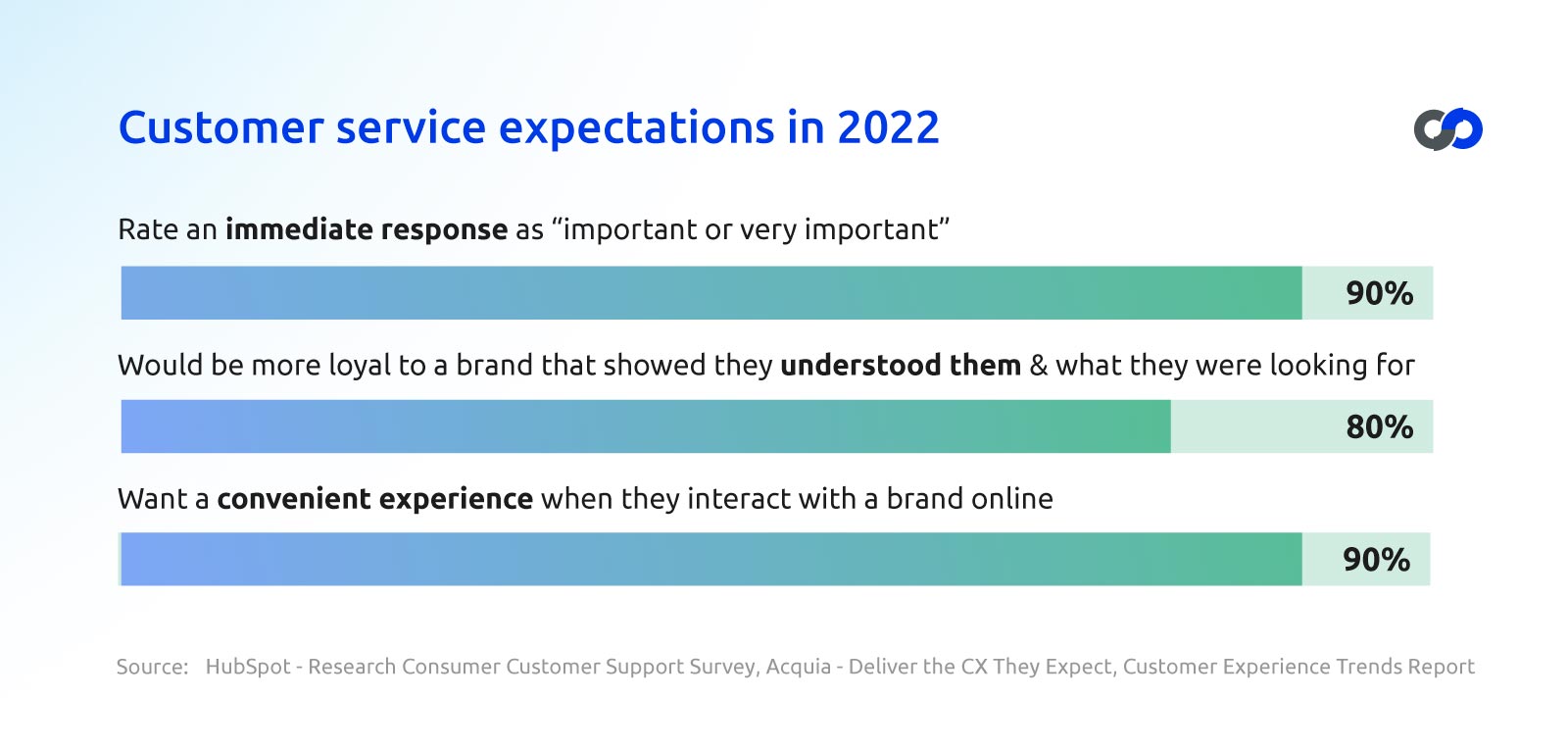
It’s no longer enough to simply provide service that is either fast or high quality. Expectations have expanded, and customers want an immediate response that also shows care and understanding. What’s more, customers want to access support in a way that’s already familiar and convenient.
With all these factors in mind, let’s look to the benefits of live chat tools to see how it addresses the concerns of today’s customers.
Introducing live chat to a website is a proven way to boost customer experience and customer satisfaction (CSAT). Why? Because it’s become the most popular support channel. In J.D. Power’s latest U.S. Chat and Email Benchmarking Study, they found that “chat is the highest-scoring channel by a wide margin”.
Live chat allows customers to reach out in a way that’s comfortable, convenient, and familiar. Connecting with an agent over live chat is incredibly easy, even for those who are not so digitally literate. Also, unlike phone calls that demand the caller’s full attention, live chat lets customers multi-task while they wait for a response.
Another key reason for live chat’s popularity is its speed. While consumers often have to be put on long hold times on the phone, or wait days for a response via email, they receive an immediate, real-time response on live chat. This speed caters to the growing desire for instant gratification – 90% of consumers consider an immediate response as ‘important or very important’. By catering to these consumer needs, chat teams can significantly improve customer satisfaction (CSAT) as a result. In 2021, the average live chat CSAT score stood at an impressive 84%.
Personalized customer service is becoming an increasingly expected experience, and those who provide it are reaping the rewards. 76% of consumers says they are more likely to be loyal to a brand if they feel they’re understood on a personal level. Brands recognize the importance of personalization too – 83% of marketers believe that personalization is a key differentiator from the competition. And yet, an overwhelming 66% of consumers believe they are still being treated like a ‘generic customer’ with no regard for their individual needs.
The best live chat software rectifies this by providing agents with a wealth of information about every visitor they speak to. Agents can see where they are located, their purchase history, previous chats, and much more all within the agent dashboard. With this information at hand, customers can receive personalized support that is truly helpful.
This personalization extends to language too. With auto-chat translation, visitors can speak with an agent in their preferred language, and the agents’ messages will be automatically translated back in that chosen language. With chat routing, support teams can ensure that visitors always reach the best person for their questions.
Pre-chat surveys are also simple but effective live chat software tools that help customers feel like their needs are understood. By simply filling out a few simple questions at the beginning of a chat, every customer can be routed to the agent, team, or department best suited to help them. This stops customers being passed between agents like an unwanted hot potato. Learn more about live chat best practices here.
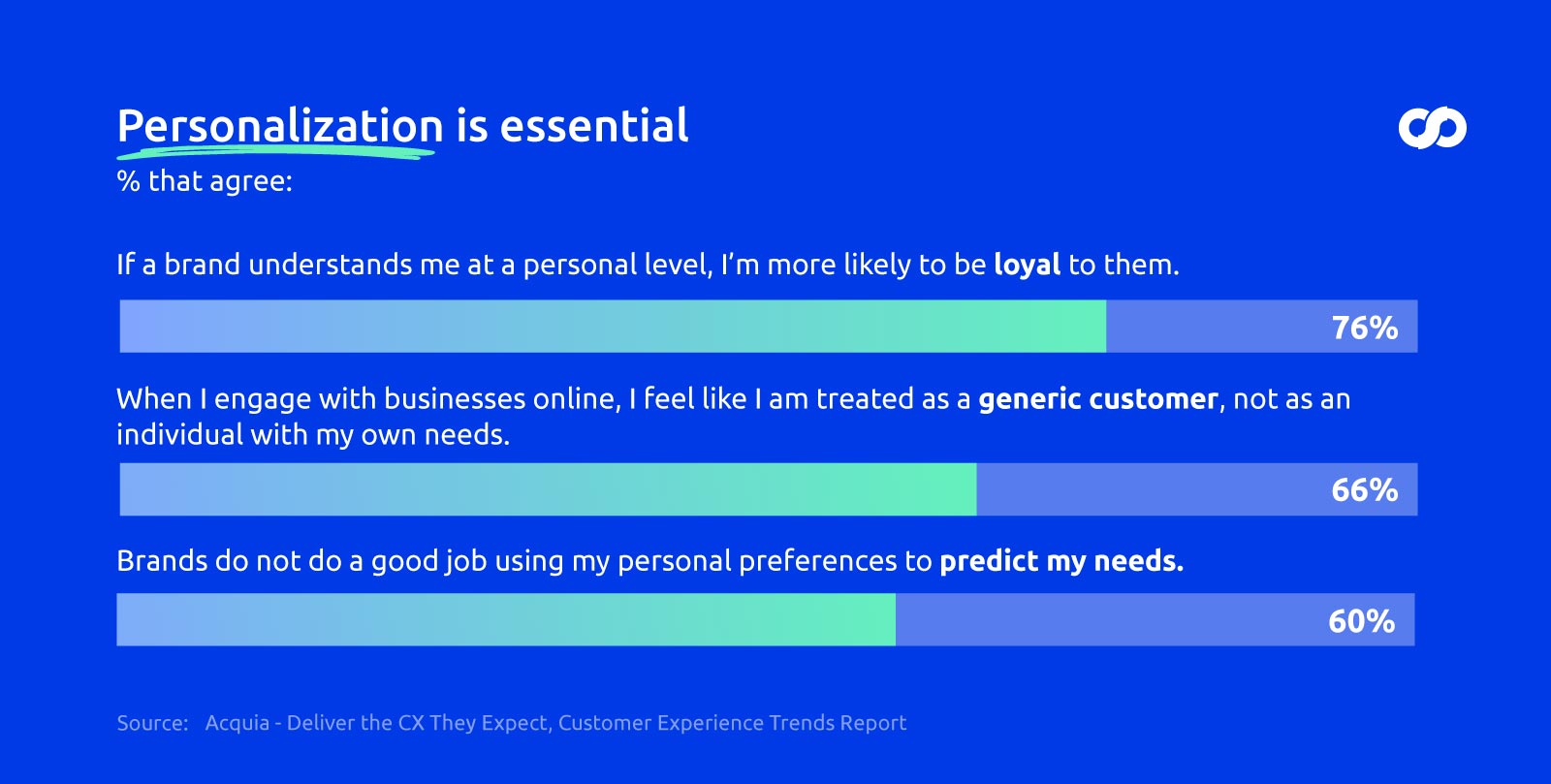
The instant, real-time nature of live chat satisfies consumers’ need for speed, but it also helps to reduce wait times. With enterprise live chat software, agents can handle multiple chats at once. This is known as chat concurrency and means that visitors don’t need to experience lengthy wait times as they so often do on the phone. Comm100 Live Chat improves this process even more by consolidating chats for agents so that there’s no need to move between open windows when working with multiple customers.
The speed of live chat support is increased even further with in-built efficiency tools. Canned messages, for example, allow agents to simply click a button to send a common response, rather than typing out the full message each time. Canned messages can be personalized by the individual or team, allowing support messages to remain personable even while they’re fired off on the fly.
One of the major reasons that businesses are moving to digital customer service is for the cost benefits. Phone support has long been used by businesses to connect with customers, but it doesn’t come cheaply. The cost of maintaining aging phone systems and providing toll-free calling to customers can quickly add up to thousands of dollars every month.
Live chat, on the other hand, is much more cost-effective. Maintenance costs are dramatically lower than phone support, and live chat software also opens the door for 3 times the agent productivity through chat concurrency and automation. Between the productivity benefits and lowered costs to support, live chat tools are less than 1/3 the cost of voice support.
One of the major reasons that businesses are moving to digital customer service is for the cost benefits. Phone support has long been used by businesses to connect with customers, but it doesn’t come cheaply. The cost of maintaining aging phone systems and providing toll-free calling to customers can quickly add up to thousands of dollars every month.
Live chat, on the other hand, is much more cost-effective. Maintenance costs are dramatically lower than phone support, and live chat software also opens the door for 3 times the agent productivity through chat concurrency and automation. Between the productivity benefits and lowered costs to support, live chat is less than 1/3 the cost of voice support.
As we’ve spoken about earlier on, live chat is the most popular customer support channel. Because consumers love using it, businesses that offer live chat can rapidly increase engagement with potential customers that they otherwise could not reach.
Canadian Blood Services enjoyed these results when they set up Comm100 Live Chat. CBS recognized that just offering telephone support was creating a barrier to engagement and reducing donor sign-ups. Once they launched live chat, they were able to connect with a much larger and previously unreachable audience and saw a significant increase in donor sign-ups.
Live chat platforms are great for organizations wanting to connect with customers abroad too. Customers anywhere in the world can easily reach out, and all without expensive international calling rates. When combined with auto-chat translation, live chat can open a company to markets they never thought possible.
One of the most underrated benefits of live chat is its ability to collect consumer insights. While phone support can collect some data, the fact that conversations are not written down and recorded means a lot of insightful information is lost. The same can be said of email as pain points of customers are only heard by one team or even individual.
In contrast, administrators and supervisors have access to all live chat histories which can be sorted, searched and filtered to quickly learn customer pain points. With this data you can also learn how your customers feel, what they need more support on, and any areas you need to improve on.
The best live chat software will offer analytics that give you valuable insight into your agents as well. Couple visitor data with access to chat histories, agent performance reports, wait time reports, and more, and you are set to monitor agent performance, and adjust staffing and training as needed.

We’ve explored why live chat is seeing wide adoption and the benefits of live chat for customer service. However, no live chat software guide would be complete without introducing some of the important features that you need to look for when finding the best live chat platform for your organization.
Personalization is one of the key benefits of live chat platforms, and audio and video chatallow organizations to take this personalization even further. By providing a video connection to customers, support agents can demonstrate their commitment to resolving a customer’s questions and concerns.
Audio or video connection helps to humanize the conversation in ways that text chat alone isn’t always capable of. For organizations that want to develop strong community connections, video chat is a great alternative to face-to-face service for those times when in-person support isn’t always possible. To ensure your customers have flexibility in how they’re served, audio and video chat are key features to look for.
Consumer trust in organizations has been shaken in recent years. Most consumers have lost confidence that brands have their best interests in mind when it comes to using, sharing, and storing data. Furthermore, a shocking 99% of consumers now believe that companies need to improve their trustworthiness.
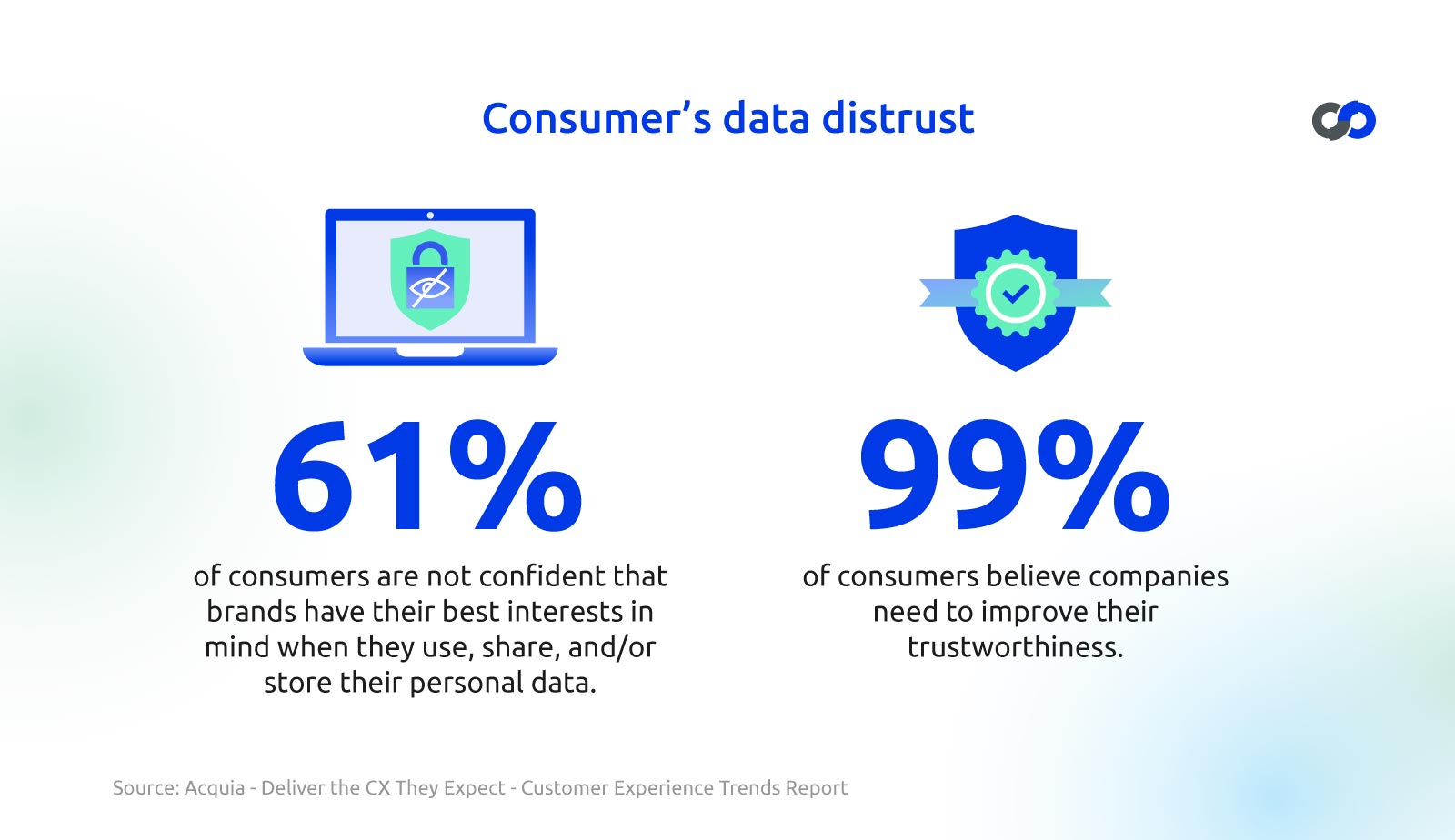
With consumer trust lower than ever and online attacks becoming increasingly common, live chat security needs to be at the forefront of any live chat software purchasing decision. One of the best ways to verify the security qualifications of enterprise live chat is to review their compliance with international and industry-specific security standards. Certifications to look for include:
Depending on your industry, choosing secure live chat software that complies with these certifications could go beyond making a smart decision – it might be mandated by law. This isn’t just about choosing the best live chat software for efficiency – it’s about making sure it’s secure.
Read more: Comm100 Security and Privacy Compliances
To provide customers with the most streamlined service, support teams need to connect customers with the right agent every time, instantly and automatically. The best live chat software offers chat routingchat routing that make this possible, saving customers from two of the most unpopular situations: getting passed around from agent to agent before connecting with someone who is able to handle their issue, and having to repeat their story over and over again – two issues that plague most telephone support.
With chat routing, chats can be programmed to automatically connect customers with specific agents or teams based on their region, customer status, agent skillset, and more. As well as streamlining support and improving CX, routing also frees agents up to specialize in specific areas of customer care, creating more effective service and avoiding re-training nightmares for organizations that already have functional workflows.
Live chat platforms are capable of transforming customer service operations, but to do so it’s important for the tool to be integrated through your entire technology ecosystem. That means ensuring that any live chat software you choose is capable of integrations with the other software systems that your organization relies on.
Example integrations for live chat platforms include:
By selecting live chat that offers easy integration with other software, you can ensure that your organization gets the most out of an investment in live chat.
It’s also important to consider whether you need on-premise or self-hosted live chat as not all software providers can do both. Here is a quick breakdown on what this means and why it matters.
Hosted live chat: A hosted, or cloud-based live chat means that the live chat software lives on a remote server (the cloud) that is owned and operated by a third-party. This is the most common deployment option, which typically sees the customer pay a small license fee. Here are the benefits of hosted live chat:
Self-hosted live chat: A self-hosted live chat means the live chat tool can run on your own server, and is often referred to as on-premise live chat. This solution comes with some security benefits, as it doesn’t require information to be stored in the cloud owned by a third-party. Here are the benefits of self-hosted live chat:
Many brands today have customers around the world. For these international customers, or customers whose first language isn’t that of their country of residence, offering support in their native language is a great opportunity to connect. While most organizations can’t afford to hire staff that speak all the languages they’d like to support, the best live chat software can fill this need with auto chat translation.
With auto chat translation, customers can use live chat with any language and receive a response in the same language. This feature allows organizations to reach entirely new markets, and easily target international visitors using foreign-language websites. For organizations supporting a diverse client base, or organizations with international aspirations, auto translation is a must.
Today’s consumers need smartphone-friendly solutions to support their increasingly mobile lifestyles. Mobile Internet traffic today accounts for almost 55% of total web traffic, meaning that you’re more likely to support a customer on their smartphone than any other device. According to Comm100’s latest Live Chat Benchmark Report, 63% of chats received in 2021 were sent by mobile. With that in mind, when you’re selecting the best live chat software, it must be accessible and easy to use from a mobile device.
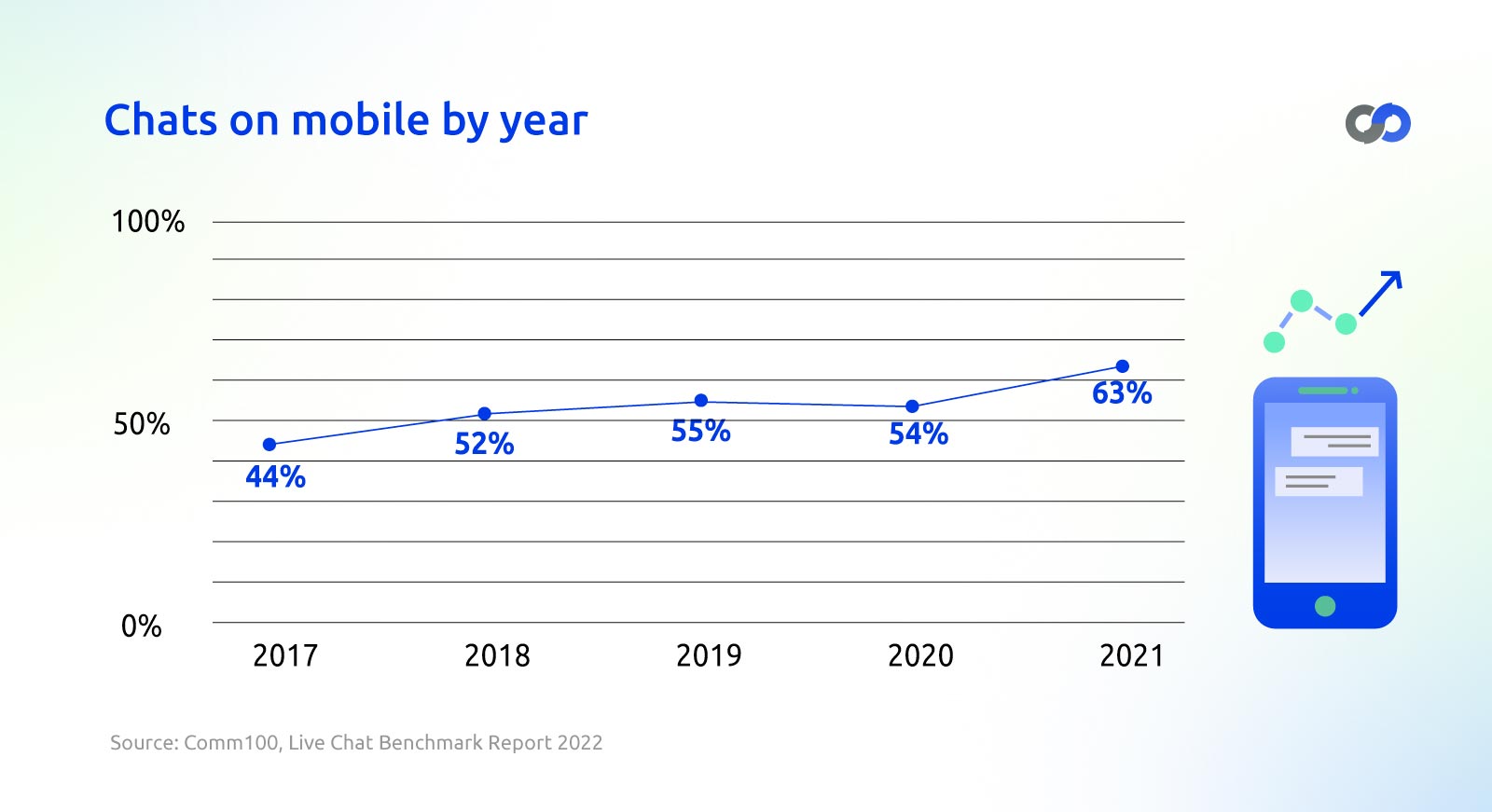
To ensure mobile compatibility with your live chat solution, you should look for a responsive design. This means that the live chat window is automatically adjusted in size and layout when your website is visited through a mobile device. Another option is adding live chat support to dedicated mobile apps. To ensure mobile app capability, look for enterprise live chat software with a developer-friendly SDK (software development kit).
One of live chat’s greatest strengths is its ability to let customers connect in ways that are comfortable and helpful. One such feature is screen sharing which lets agents instantly view a visitor’s web browser and visa versa. Whether it’s help with a highly technical process or just a quick point in the right direction, screen sharing allows agents to easily guide customers toward a solution.
Like security, privacy is an imperative for customer trust. Thankfully, screen sharing solutions are built with privacy in mind to mask personal details like credit card information from agents. Because no downloads are needed, screen sharing can be initiated with a simple agent request and customer acceptance. Because screen sharing is a powerful tool in any support environment, it’s important to look for this feature when choosing the best live chat software.

This live chat software guide has explored just some of the many benefits that live chat can bring to an organization’s customer experience – yet there are many more ways it can improve the customer lifecycle, from lead generation, to sales, to after-sales support.
For a better understanding of the ways that live chat could benefit your organization, this chapter showcases live chat examples and use cases to inspire you.
Canadian Blood Services (CBS) is a non-profit organization that provides blood transfusion and transplantation services. The ability of CBS to provide these lifesaving services is heavily dependent on its ability to attract and retain donors. However, they were primarily relying on phone and email to connect with these donors and recognized that an accessible digital channel could greatly improve donor bookings.
To this end, CBS introduced Comm100 Live Chat on their site. This enabled them to provide a popular, real-time channel to potential donors, answering their common FAQs and organizing donor bookings. Live chat removed a significant barrier to engagement and allowed them to connect with many more people who they otherwise were unable to reach. As Denny Michaud, Customer Relations Manager at CBS, explained:
“As telephone support was becoming less and less popular, live chat has enabled us to reach a whole new audience that we otherwise were missing out on.” – Denny Michaud, Customer Relations Manager, Canadian Blood Services
CBS’ live chat team now receives over 7000 chats every month. Importantly, their call volume has not decreased which shows that these new digital engagements over chat represent a new audience of donors that they were missing when only offering telephone and email support.
Read the full story – Comm100 Live Chat Helps Canadian Blood Services Connect with Digital-First Customers
Thompson Rivers University (TRU) was founded in 1970 and serves more than 25,000 students across its two campuses and online. TRU is a fantastic live chat example that showcases how higher education can meet students’ high digital support expectations. Back in 2019, they began to recognize that they were failing to provide their students with the digital support experience that they had become accustomed to from other industries.
Live chat was identified as the ideal solution to fix this problem and so they initially implemented Comm100 Live Chat into their Future Students team. This popular digital channel immediately helped TRU to connect with more students and boost their recruitment efforts. Seeing this success, four more departments soon adopted live chat too. The International Office adopted chat to increase international student engagement, while the Wellness Center department offered chat to provide personal, one-to-one guidance to students in need of support.
“The traditional way of communicating over just phone and email has become antiquated, especially within higher education. If you’re only offering phone and email support, you aren’t providing your students with the experience they need and expect, and this could damage everything from enrolment to drop-out rates.” – Lachlan Todd, Communications & Systems Coordinator, Thompson Rives University
Read the full story – Thompson Rivers University Adopts Comm100 Live Chat & Chatbot Across 5 Departments
Fitbit Health Solutions is the business to business (B2B) arm of Fitbit, the maker of popular fitness-tracking hardware. Their sales team relies on quick engagement with prospects to close sales, and they saw that their slow online forms were holding up the process.
After researching options for digital engagement, Fitbit Health Solutions introduced Comm100 Live Chat to decrease their response time, and saw immediate results:
“To date, we have $6 million in opportunities sourced from chat and have closed about $4 million of that. In addition, our sales team loves it. The handoff from support is seamless, it’s brought in great leads, and has led to shorter sales cycles.” – Joanie Gentile, Sr. Business Operations Manager, Fitbit
Comm100 Live Chat has created a faster and more frictionless sales cycle for Fitbit Health Solutions, leading to significant new sales. With features that improve customer interactions and provide seamless integration between teams, live chat is a proven way to improve the sales process.
Read the full story – Fitbit generated $6M in pipeline with help from Comm100 Live Chat
Cabrillo Credit Union is the primary financial institution of U.S. Border Patrol employees. As a financial cooperative, Cabrillo is dedicated to providing superb member service and support.
To this end, Cabrillo introduced Comm100 Live Chat. Live chat quickly gained popularity among Cabrillo’s members for its speed. Compared to phone wait times of 45 to 50 seconds, live chat waits were only 15 seconds in length. It was also appreciated for its ease of use, regardless of digital literacy as Kelli Davis, Cabrillos’ VP of Member Support, explained:
“It wasn’t much of a surprise to see the younger generations engaging first… but we are starting to see Baby Boomers learning the technology and using the chat. It does require some patience by our agents as they discover the technology, but our members appreciate it, and they love using it.”
It was important for Cabrillo to retain a personal relationship with their members, and Comm100 Live Chat has allowed them to do just that, as Kelli explained: Live chat can be very personal. Often people think you can’t engage the same way you can on the phone, but you can. It’s fun, members like it”.
Read or watch the full story – How Cabrillo Credit Union is Transforming Member Engagement with Comm100 Live Chat & AI Chatbot

When adding live chat to your support operations, it’s important to track the key live chat statistics to learn how well your team is performing. However, if you don’t know how other teams of the size same and industry are performing, it can be difficult to know how well you’re really doing.
This chapter reveals the key live chat metrics so you can know exactly where your team is excelling, and where it needs work. For a more in-depth analysis with data broken down by team size and industry, download our free 2025 Live Chat Benchmark Report below.
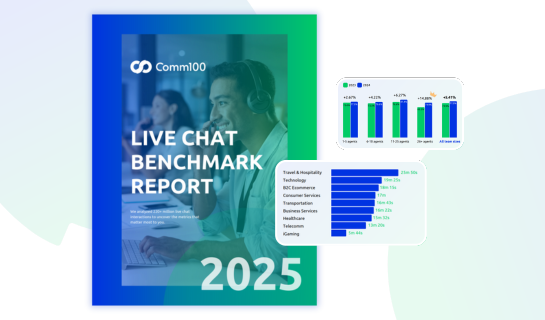
Discover the latest live chat benchmark data to understand how well your team is performing compared to the competition and where it needs to improve.
Wait times measure the time until agent response for a chat. In 2021, wait time for chats was 36 seconds. Wait times didn’t see an appreciable change from 2020, showing that live chat teams are understanding the importance of keeping waits low.
It’s important to note the relationship between wait times and CSAT. On the one hand, low wait times seem to indicate higher CSAT. Wait times under 60 seconds saw a CSAT rate of 82.5%, while increasing waits to 5+ minutes resulted in a CSAT rate of 69.5%. However, highest CSAT rate overall was among wait times of 1-2 minutes, showing that achieving short wait times should not come at the expense of quality service. High quality service still ranks first among customers.
Chat duration looks at the total time of a live chat interaction. Like wait times, average chat duration did not change significantly in 2021 from the previous year, only increasing by 2%. The average chat duration in 2021 was 11 minutes and 9 seconds.
While chat duration did not significantly change year-over-year, looking at previous years ending in 2019, this still signals a trend. Between 2019 and 2020, chat duration rose by 18%. This trend indicates an overall industry shift away from fast resolutions and towards improved customer experience (CX) as organizations recognize the benefits excellent CX can create.
When considering live chat benchmarks, customer satisfaction (CSAT) is always top of mind. CSAT rates are measured as interactions with a customer rating of 3/5 or higher. Overall, live chat CSAT rates decreased by 1.6% in 2021, for an average positive customer satisfaction rate of 84%.
Although this is a slight decrease from the previous year, 84% is still a historically high average satisfaction rate among live chat interactions. A closer look at the data shows that this decrease could be due to increases in chats per agent. It’s important to be mindful that agents aren’t handling too many simultaneous chats, or these kinds of decreases in CSAT can be anticipated.
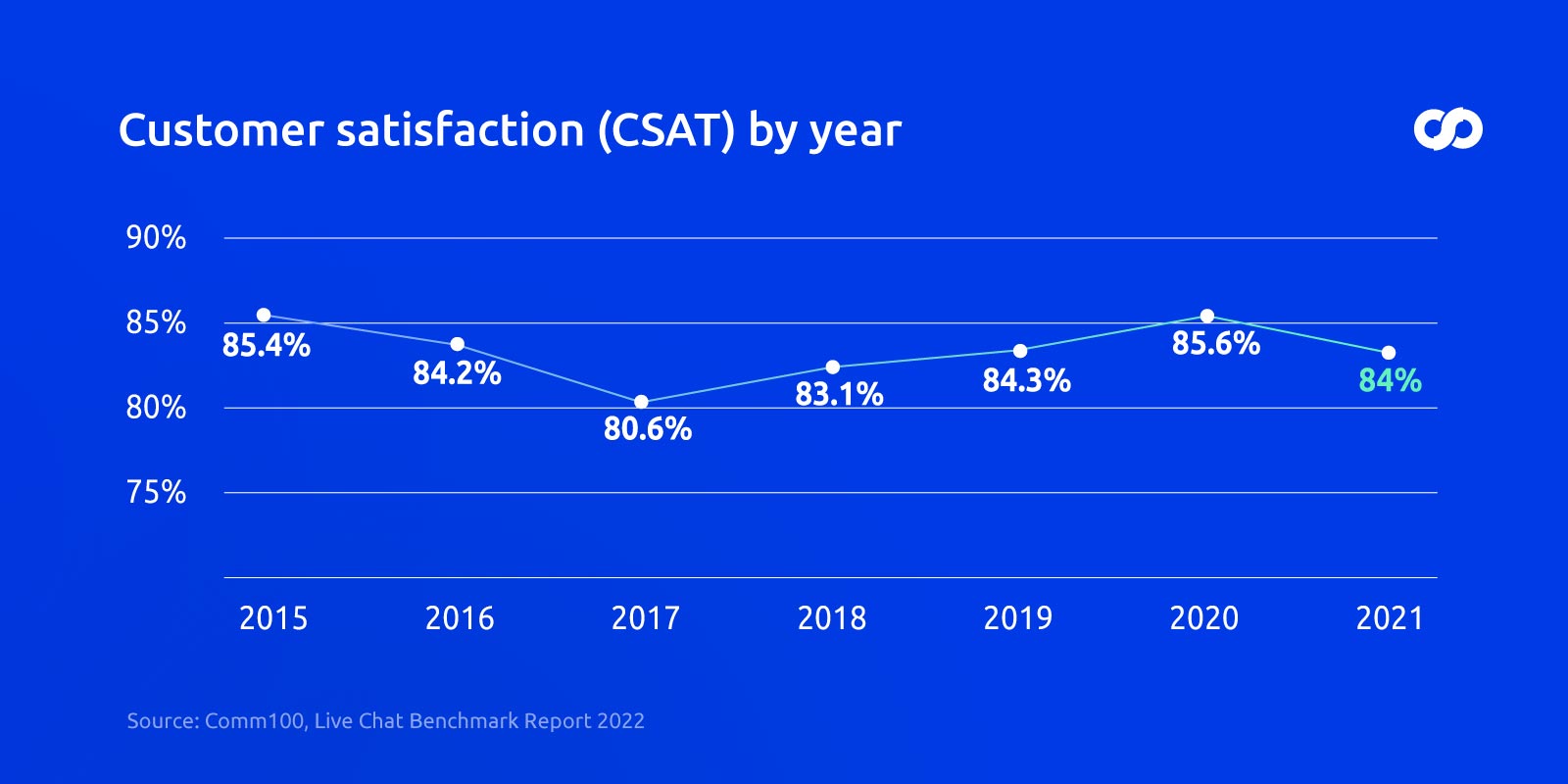
Chats on mobile looks at the percentage of chats sent from mobile devices. In 2021, mobile chats hit an all-time high of 63% of total chats.
Surprisingly, the smallest team sizes typically see the highest percentage of mobile chats. This unexpected outcome points to the simplicity of introducing live chat software in 2021, as we see teams of all sizes offering chat via mobile.
Read the full report here – Live Chat Benchmark Report
We hope you’ve enjoyed this comprehensive live chat software guide. If you want to level-up your digital support capabilities and achieve digital customer experience excellence, book a demo with Comm100’s live chat specialists.
Comm100 is a global provider of enterprise live chat software solutions for education, government and commercial organizations of all sizes. With Comm100, organizations can provide excellent digital customer experiences through configurable, value-driven live chat, secure messaging, AI powered bots and automation within one integrated console.
There’s a lot more where this came from!
Get our monthly customer service news and best practices update delivered to your inbox.

Article by
Kate is the Content Marketing Specialist at Comm100. She has extensive experience in content creation for technology companies across the world, including the UK, Australia and Canada. She specializes in B2B messaging, branding and soccer trivia.